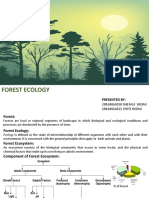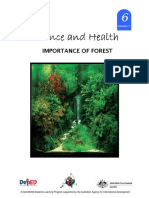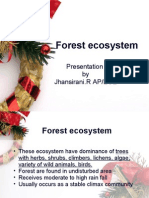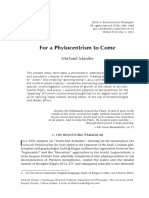Course Code and Title : MST (Environmental Science)
Lesson Number : 9 - 14
Topic : Major Type of Ecosystem
Overview
All types of ecosystem fall into two categories: terrestrial or aquatic. Terrestrial ecosystem is land-
based while aquatic ecosystem is water-based. Within any ecosystem, specific features vary widely. The
major type of land-based ecosystem includes forests, desert, grassland, and tundra while water-based
ecosystem consists of the ocean, lakes, and rivers.
Learning Objectives:
At the end of the course, the student shall be able to:
1. Identify the specific features of the major types of ecosystem.
2. Recognize the importance of the different ecosystems.
3. Formulate control measures to protect the ecosystem.
Module Titles
Module 9 – Tropical Forest Ecosystem
Module 10 – Desert Ecosystem
Module 11 – Grassland Ecosystem
Module 12 – Estuarine Ecosystem
Module 13 – Freshwater Ecosystem
Module 14 – Ocean Ecosystem
1
� Module 9
Tropical Forest Ecosystem
Introduction
Forest ecosystems are classified
according to the climate type as tropical,
temperate, or boreal. In the tropics located
in the equatorial and subequatorial regions,
rainforest ecosystems contain more diverse
flora and fauna than ecosystems in any
other region of the earth. In these warm,
moisture-laden environments, trees grow
tall and foliage is lush and dense with
species inhabiting the forest floor all the
way up to the canopy. In temperate zones
which include veldts of Africa, Hungary,
Argentina, Russia, America and Eurasia, forest ecosystem may be deciduous, coniferous, or oftentimes a
mixture of both in which some trees shed their leaves each fall while others remain evergreen all year
round. In the Arctic, boreal forests (Taiga) feature abundant coniferous trees. (Harris, 2010). This module
will focus on the tropical dry forest and tropical rainforest ecosystems.
Learning Objectives:
At the end of the lesson, students should be able to:
1. Describe the main features of a tropical forest ecosystem.
2. Identify the role of tropical forests in the environment.
3. Compile textual evidence that tropical forests are significant to the survival of biotic components.
Pre-Assessment
Choose the letter of the best answer.
1. The forest is the most diverse of all the ecosystem because __________
a. It is a habitat for many species of plants and animals.
b. There are many wild animals in it.
c. It occupies a large area.
d. It is green in nature.
2. Forests are considered the “lung of the earth”. It means __________
a. They draw in carbon dioxide and breathe out oxygen.
b. They draw in oxygen and breathe out carbon dioxide.
c. They filter pollutants.
2
� d. There are many tall trees in the forest.
3. Types of forest, except:
a. Temperate
b. Tropical
c. Rainforest
d. Boreal
4. The bottom most layer of the forest is the forest floor. The topmost is called _________.
a. Canopy
b. Understory
c. Shrub
d. Aerial
5. Many tropical forests are now being cut down by humans and convert it to __________.
a. Farmland
b. Housing
c. Urban area
d. All the choices
Lesson Presentation
A forest ecosystem is a natural woodland unit consisting of biotic components (plants, animals,
and microorganisms) in that area functioning together with abiotic factors of the environment. There are
six layers withing a forest consisting of:
1. Upper canopy
2. Low-tree layer
3. Shrub under story
4. Ground layer of herbaceous plants
5. Forest floor
6. Root layer
Each layer receives a different amount of sunlight and rainfall, so different types of animals and
plants are found in each layer.
Distribution. Tropical forest occurs in the equatorial and sub-equatorial regions.
Precipitation. In tropical rainforests, rainfall is relatively constant about 200-400cm annually. In
tropical dry forest, precipitation is highly seasonal about 150-200cm annually with a six to seven months
dry season.
Temperature. High year-round averaging 25-29°C with little seasonal variation.
Plants. Tropical forests are vertically layered and competition for light is intense. Layer in
rainforest include trees that grow above a closed canopy, layers of shrubs and herbs. There are generally
3
�fewer layers in tropical dry forests. Broadleaf evergreen trees are dominant in tropical rainforests whereas
many tropical dry forest trees drop their leaves during dry season. Epiphytes such as bromeliads and
orchids generally cover tropical forest trees but are less abundant in dry forests. Thorny shrubs and
succulents are common in some tropical dry forest.
Animals. Earth’s tropical forests are home to millions of species including an estimated 5-30
million still undescribed species of insects, spiders, and other arthropods. In fact, animal diversity is higher
in tropical forests than in any other terrestrial biomes. The animals including amphibians, birds, and other
reptiles, mammals, and arthropods are adapted to the vertically layered environment.
http://www.rainforest-facts.com/temperate-deciduous-forest.html
IMPORTANCE OF FOREST TO THE ENVIRONMENT
Forests form a third of all land on earth providing vital organic infrastructure for some of plant’s
densest and most diverse collections of life.
1. Forest support countless species as well as 1.6 billion human livelihoods.
2. Forest products are used in daily life. The fruits, paper, and wood from trees go into daily
manufacturing of goods. Forest by-products like medicine, cosmetics, and detergents are also
used daily.
3. Forests are very important in biodiversity and livelihood for humans.
4. Forests provide habitat to diverse species.
5. Forests offer water shed protection, provide timber and non-timber products, and
recreational venue.
6. Forest prevent soil erosion; help maintain the water cycle and check global warming by using
carbon dioxide in photosynthesis.
References
1. Exploring Ecosystem: Tropical Rainforest Diversity
- https://www.youtube.com/watch?v=LHPuo0rwM1w
4
� 2. 25 Facts About the Amazon Rainforest
- https://www.youtube.com/watch?v=DgU7gsBOhUI
3. https://www.slideshare.net/kainexah_05/major-types-of-ecosystems
Assessment
We depend on forest for survival, from the air we breathe to the wood we used. Without forests,
life would adversely be affected.
Make a compilation of textual evidences that tropical forests are important to the survival of biotic
components, including man. Cite your sources in APA format. (minimum of 3; maximum of 5)
https://www.iucn.org/resources/issues-briefs/deforestation-and-forest-degradation
Reinforcement
Forests consist not only of living components like trees, animals, and different kinds of plants but
also non-living components such as soil, water, air, and landform. All these components make up a forest
ecosystem. The importance of forests cannot be underestimated because living things including man
depend on the forest for survival.
In the next module, another terrestrial ecosystem will be explored. It is located in arid regions
associated with warm temperature.






















































































